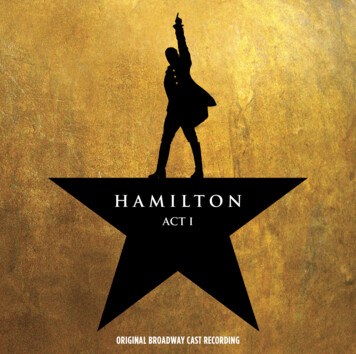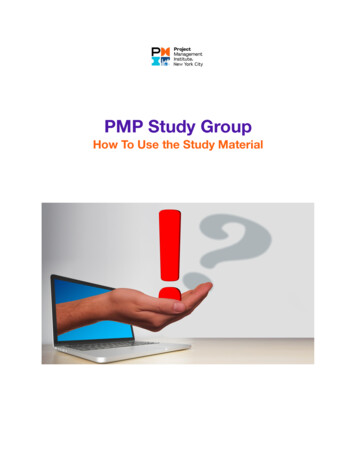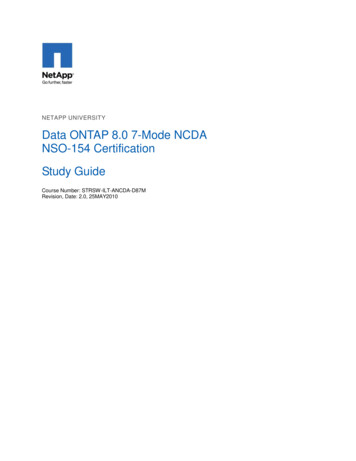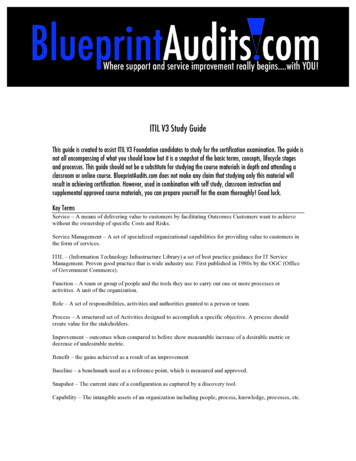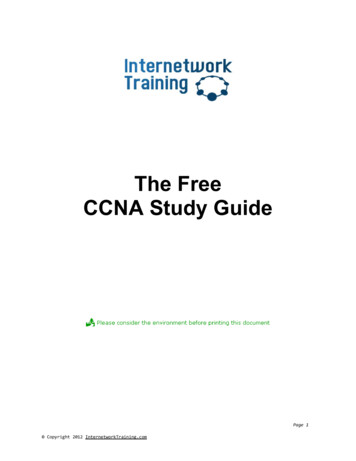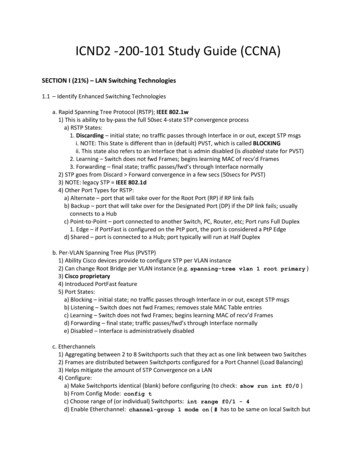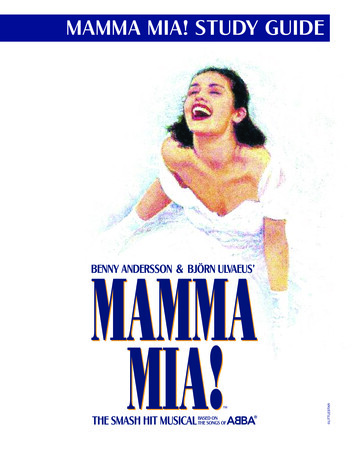
Transcription
TM LITTLESTARMAMMA MIA! STUDY GUIDE
TABLE OF CONTENTSWELCOME TO MAMMA MIA!STORY SUMMARYMEET THE CHARACTERSBACKGROUND INFO: MUSICAL HISTORYENGLISH/LANGUAGE ARTSHISTORY/SOCIAL STUDIESMUSICTHEATERRESOURCESTM
WELCOME TO MAMMA MIA!TELL ME PLEASE, ‘CAUSE I HAVE TO KNOWI’M A CURIOUS CHILD, BEGINNING TO GROWAND YOU MAKE ME TALKAND YOU MAKE ME FEELAND YOU MAKE ME SHOWWHAT I’M TRYING TO CONCEAL–Words and lyrics by Benny Andersson and Björn UlvaeusSophie seems to have everything going for her. She’s about to get married to the man she loves. She liveson a beautiful Greek island with a mother who cares about her. Her life should be perfect, but somethingis missing. Although she’s been raised by her loving mother, she’s never met her father. In MAMMA MIA!,Sophie longs to find out the truth about who she is; with three letters in the mailbox, she hopes to createwhat she’s never had: a traditional family. With the help of her mother and friends, she discovers that families come in many different shapes and sizes, and that love doesn’t always need to follow the rules.With its wonderful songs and magical story, MAMMA MIA! offers young people a unique opportunity: to usean exciting musical as the launching point for a wide variety of discussions, activities and lessons.Sophie’s mother, Donna, came of age during the 1970s, a turbulent time when music, culture and socialnorms all went through wild changes. Donna sees her daughter growing up in the present day and tries –as all parents do – to help Sophie avoid the mistakes she made in her youth. MAMMA MIA! will allowyoung people to explore the era of the 1970s and compare it to their own time.This guide is written to help educators merge a trip to MAMMA MIA! with a curriculum that includes English/Language Arts, Social Studies, Theater, and Music. Each section in the guide includes lesson plans, activities and ideas for discussion, along with appropriate standards and goals. Resources for furtherexploration can be found on page 33.Using this guide, educators and students will be able to make a trip to MAMMA MIA! educational, as wellas fun.www.mamma-mia.com www.mammamiafanclub.com1
STORY SUMMARYACT ONEThe story opens on the beach of a beautiful Greek island. Sophie, a young,hopeful woman, is about to mail three invitations. She takes a moment tothink about what she’s doing (“I HAVE A DREAM”) then drops the letters intothe mailbox.Suddenly, two of Sophie’s old friends, Ali and Lisa, appear. They are there fora very special occasion: Sophie is getting married! But even Sky, Sophie’s fiancé,doesn’t know the secret she now reveals to her friends: Years ago, Sophie’smother, Donna, knew three men, and one of them is Sophie’s father (“HONEY,HONEY”). It is these three men, Sam Carmichael, Bill Austin and Harry Bright,that Sophie has invited to her special day. It’s her dream to have her real fathergive her away on her wedding.up a planDonna dreamslthy man!eawto get aJust as Sophie is plotting with her friends, her mother, Donna, is reminiscing with her old pals, Rosie and Tanya, who have also come to the island forSophie’s wedding. Donna, Rosie and Tanya were once a pop singing groupcalled “Donna and the Dynamos.” Donna introduces her friends to Sophie’sfiancé, Sky, along with Pepper and Eddie, the waiters at Donna’s hotel/bar,the Taverna. After fifteen years of running the place, Donna is readyfor some success (“MONEY, MONEY, MONEY”).As Donna and the girls exit, Sam, Harry and Bill arrive at theTaverna and meet Sophie. Sophie wants to keep the reasonfor their presence on the island a secret from Donna (“THANKYOU FOR THE MUSIC”). Suddenly Donna comes in and seesthe three men. All of her old feelings come bubbling to thesurface (“MAMMA MIA”).Donna dto get areams up a planwealthyman!Donna can’t hide her emotions from Rosie and Tanya (“CHIQUITITA”). Rosie and Tanya try to comfort Donna, rememberingtheir old days on stage (“DANCING QUEEN”).planup a an!smadret hy mDonnaet a wealto gIn the meantime, Sophie, too, is in turmoil at the arrival of her“three Dads.” She needs Sky to comfort her (“LAY ALL YOUR LOVE ON ME”).a planDonna dreams up man!ythalweatto geWhile the boys are having Sky’s bachelor party, the girls listen to “Donna andthe Dynamos” sing one of their old tunes (“SUPER TROUPER”). Harry,Bill and Sam arrive at the party, only to be welcomed into the dancewww.mamma-mia.com www.mammamiafanclub.com2
STORY SUMMARY Continued.(“GIMME, GIMME”). Sophie speaks with each of her potential Dads. Billis very close to learning the secret (“NAME OF THE GAME”). He promisesto give her away at the wedding the next day.All the townspeople meet in the courtyard to celebrate Sophie and Sky(“VOULEZ-VOUS”). Sam takes Sophie aside to say that he would be proudto be her father. He promises to walk her down the aisle at the wedding.Then Harry meets her and promises the same thing! Sophie is stunned asthe curtain falls.up a planDonna dreamslthy man!eato get a wACT TWOAs the second act begins, Sophie is having a nightmare (“UNDER ATTACK”). Upon awakening, Sophie is confronted by Donna who thinks she wants to cancel the wedding. But Sophie is determinedto not repeat what she sees as her mother’s mistake: raising a child without afather. Donna is left with her thoughts (“ONE OF US”), until she meets Sam.They reach out to each other, but are held back by pride (“S.O.S.”).The guests begin to gather for the wedding. Tanya flirts with Pepper(“DOES YOUR MOTHER KNOW?”).Sophie finds Sky and confesses that she invited Harry, Bill and Sam, hoping that one of them would be her real father. Sky is upset that she didn’ttell him the truth. Sam tells Sophie that she shouldn’t get married unlessit’s what she really wants (“KNOWING ME, KNOWING YOU”).Donna dto get areams up a planwealthyman!In Donna’s room, Donna and Harry reminisce about their past (“OURLAST SUMMER’). Sophie comes in, and although there is still tensionbetween them, she asks Donna to help her dress for the wedding (“SLIPPING THROUGHMY FINGERS”). Sophie asks Donna to give her away at the wedding.As Rosie puts the final touches on the wedding arrangements, she asks Bill if there is a chancefor their relationship to grow (“TAKE A CHANCE”).The wedding begins. Before Sky and Sophie can take their vows, Donna breaksin, telling everyone that Sophie’s real father is there. Sophie reveals that she hasread Donna’s diary and invited Sam, Harry and Bill. The three men agree to ALLbe Sophie’s dad. Sophie and Sky decide to postpone the wedding and explore theworld together. But before the wedding decorations can be taken down, Sam asksDonna to marry him (“I DO, I DO, I DO, I DO, I DO”).Donna dreamsto get a wealt up a planhy man!www.mamma-mia.com www.mammamiafanclub.com3
MUSICAL HISTORYDuring the 1970s, the Swedish pop group ABBA became one of the most popular musical groups in theworld. With phenomenal songs like “Waterloo,” “Dancing Queen,” and, of course, “Mamma Mia,” ABBA’ssound swept the world with its optimism, joyful lyrics and infectious beat.Today, music permeates every aspect of our lives; therefore, an investigation into the origins and importanceof popular music such as ABBA’s will enrich a trip to see MAMMA MIA!WHAT IS “POP” MUSIC?To understand and appreciate the music of ABBA and the story of MAMMA MIA!,you need to understand what we mean by the term “popular” music.Donna dreams up ato get a wealthy maplann!What do you think of when you hear the word “popular”? The best? Well-liked? “Popular” is really derived from the Latin word “popularis,” or “of the people.” So “Popular Music” (or “Pop” music, as it’s come to be known) is the music loved by thepeople, not the music critics or professors tell us we should enjoy. And because “pop”music is the music the people love, listening to it and discussing it are interesting waysto learn about a culture: its history, its concerns, its storytelling, its desires. “Pop”music is the voice of the people, singing their story.FOLK MUSICToday, we take music like ABBA’s for granted. Music is everywhere. We hear it on the radio, on CDs, on theInternet. We hear music in the background on television shows and movies. We hear music in our cars, onairplanes, even in space. We hear music when we wake up in the morning, and before we go to bed at night.It wasn’t always this way. Before the advent of technology that made the widespread of music possible,music was seen as the forum for the talented: Those who could not play an instrument, or felt they couldnot sing, did not have music in their lives. Those who could make music often passed that music down,from generation to generation. Music in the oral tradition, passed down by word of mouth, is known as folkmusic.How is folk music different from popular music? What we know today as popular music came about whentechnology made a wider dissemination of music possible. With the coming of technology designed towidely circulate information and entertainment – a “mass media” – people did not need talent or passeddown tradition to appreciate and enjoy music.In the United States, the first step in this wide spread of music was a step down a special street called TinPan Alley.www.mamma-mia.com www.mammamiafanclub.com5
MUSICAL HISTORY Continued.TIN PAN ALLEYImagine walking down the street in New York City at the end of the 19th century. All of a suddenyou’re blasted with a strange, yet somehow beautiful sound. From every open window along thestreet you hear the sound of pianos banging out tunes. Songwriters hold their pencils, trying towrite the next big hit. The sound is raucous, gorgeous, obnoxious, great. It sounds like the clanging of tin pans together, calling the world to attention. A new way of spreading music is beingborn.Tin Pan Alley was the nickname given to 28th Street between Fifth Avenue and Broadway, the stripin Manhattan where music publishers had their offices. Later, the name encompassed the entiremusic industry. Before radio and records, music publishers sold their songs through sheet music.Many homes had pianos, and people entertained themselves with Tin Pan Alley’s simple andcatchy tunes.By meeting the public’s need for sheet music, Tin Pan Alley was the world’s first self-containedindustry devoted exclusively to creating new songs. Tin Pan Alley music publishers hired composers and lyricists for the express purpose of writing new songs.To get the word out about their songs, Tin Pan Alley publishers used “song pluggers” to sing onstreet corners, in bars and theaters. The number of copies of sheet music it sold determined asong’s popularity. In the world of Tin Pan Alley, the songwriter was the star; those songwriters whosold the most copies gained money and fame. Many of America’s greatest songwriters startedtheir careers as Tin Pan Alley song pluggers and songwriters: names like Irving Berlin, GeorgeGershwin, Cole Porter and Richard Rodgers.Later, the creation of radio allowed singing stars to become more and more popular, and singerslooked to Tin Pan Alley to create songs exclusively for them. At first, Tin Pan Alley embraced therecording industry. What were records, after all, but another way to get people to buy their sheetmusic?But after World War II, the recording industry overcame the Tin Pan Alley publishers. The stars andtheir performances, recorded forever on vinyl records, became more important than even the musicitself.In 1954, Bill Haley and the Comets had the first international rock ‘n’ roll hit: “Rock Around theClock.” It was the record, not the sheet music, which sold to millions of teens around the world.Many see this as the end of Tin Pan Alley, and the birth of a little thing they called rock ‘n’ roll!www.mamma-mia.com www.mammamiafanclub.com6
MUSICAL HISTORY Continued.ROCK AND ROLLDuring the 1950s, the life of the American teenager changed dramatically. World War II was over;America’s economy was riding high. After the Great Depression of the 1930s and the horrors ofWorld War II in the 1940s, parents were eager to give their kids everything they themselves hadlacked. More teenagers went to college; they had more free time and were able to have more fun.As singer Jo Stafford said in 1958, "Rock and Roll is an economic thing. Today's nine- to fourteenyear-old group is the first generation with enough money given to them by their parents to buyrecords in sufficient quantities to influence the market. In my youth if I asked my father for 45 centsto buy a record, he'd have thought seriously about having me committed."This new freedom coincided with a new music and new technology for spreading it around. Themusic, a raucous sound influenced by bluegrass, gospel, jazz and rockabilly, became the soundof this new generation. In 1952, DJ Alan Freed was the first to call it “rock ‘n’ roll.”The growth of the recording industry and radio combined with a young audience eager to separate themselves from the culture of their parents, all spurred the popularity of rock ‘n’ roll. Songwriters like Jerry Lieber and Mike Stoller, who wrote such hits as “Hound Dog,” “Yakety Yak,”“Love Potion No. 9,” and “Poison Ivy,” and such performers as Elvis Presley, the Drifters and BenE. King, all led the way.Unlike the Tin Pan Alley songwriters, who only sold you the song on sheet music, the creators ofrock ‘n’ roll’s classics used the technology of recording to sell you a performance. Now singers andmusicians were the stars, while the songwriters often melded into the background. As Lieber andStoller said, "We didn’t write songs, we wrote records.”www.mamma-mia.com www.mammamiafanclub.com7
MUSICAL HISTORY Continued.IN THE BEGINNING – THERE WAS ABBA!In 1966, two Swedish pop stars, Björn Ulvaeus andBenny Andersson, met, and later began to record together. On their second single, the backing vocalswere sung by their fiancées, Agnetha Faltskog andAnni-Frid Lyngstad, the first time the group sang together. Saddled with an awkward name, “Bjorn &Benny, Agne
During the 1970s, the Swedish pop group ABBA became one of the most popular musical groups in the world. een,”and,ofcourse,“MammaMia,”ABBA’s sound swept the world with its optimism, joyful lyrics and infectious beat.

